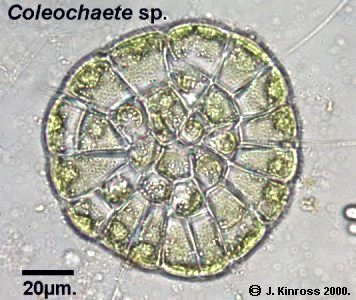

Identify that alga:
Web-based key to genera -13: attached cushions with chloroplasts
Algal Search Sitemap and quick links |
|||||||
Jump to: (filename) |
unbranched cyanobacteria (search5) |
branched cyanobacteria (search6) |
|||||
attached, flat plate (search13) |
|||||||
Colonies and coenobia : Cyanobacteria (search21) |
|||||||
Unicells (under development) |
non-flagellate cells without case (under development) |
in silica case = diatoms (under development) |
flagellate cells (under development) |
||||
no chloroplast: |
|||||||
Click on the underlined text link to jump to the next step:
| Attached; round cushion of cells: | (with a well-defined outline - distinguish from a flat disk of irregular shape) | |||
| Click on the thumbnail for a larger image | ||||
|
 Coleochaete: the sheathed bristle is indicative; it is actually pseudoparenchymatous; other species are more obviously so, or filamentous. [Bristle, synonymous with seta = a stiff projecting fibre] |
|||
|
 Chaetopeltis [Pseudocilium = flexible, but not motile, projecting fibre] |
|||
| (pseudo) parenchymatous plate | Parenchymatous: Psudoparenchymatous: |
|||
|
 Monostroma |
|||
|
||||
|
|
|||
|
 Stigeoclonium: other spp. have a less well-developed basal system than the one illustrated. This (S. farctum) also appears to have concentric rings in the basal disc, due to the chloroplasts in adjacent filaments being aligned. See branched filaments |
|||
|
Pseudendoclonium | |||
John Kinross